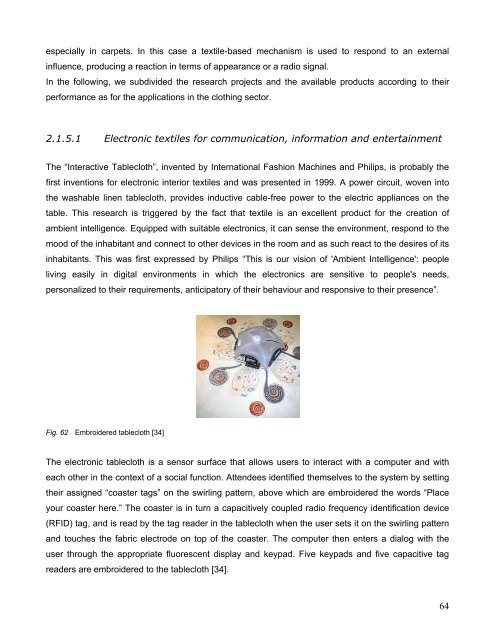Clevertex - Grado Zero Espace Srl
Clevertex - Grado Zero Espace Srl
Clevertex - Grado Zero Espace Srl
Create successful ePaper yourself
Turn your PDF publications into a flip-book with our unique Google optimized e-Paper software.
especially in carpets. In this case a textile-based mechanism is used to respond to an external<br />
influence, producing a reaction in terms of appearance or a radio signal.<br />
In the following, we subdivided the research projects and the available products according to their<br />
performance as for the applications in the clothing sector.<br />
2.1.5.1 Electronic textiles for communication, information and entertainment<br />
The “Interactive Tablecloth”, invented by International Fashion Machines and Philips, is probably the<br />
first inventions for electronic interior textiles and was presented in 1999. A power circuit, woven into<br />
the washable linen tablecloth, provides inductive cable-free power to the electric appliances on the<br />
table. This research is triggered by the fact that textile is an excellent product for the creation of<br />
ambient intelligence. Equipped with suitable electronics, it can sense the environment, respond to the<br />
mood of the inhabitant and connect to other devices in the room and as such react to the desires of its<br />
inhabitants. This was first expressed by Philips “This is our vision of 'Ambient Intelligence': people<br />
living easily in digital environments in which the electronics are sensitive to people's needs,<br />
personalized to their requirements, anticipatory of their behaviour and responsive to their presence”.<br />
Fig. 62 Embroidered tablecloth [34]<br />
The electronic tablecloth is a sensor surface that allows users to interact with a computer and with<br />
each other in the context of a social function. Attendees identified themselves to the system by setting<br />
their assigned “coaster tags” on the swirling pattern, above which are embroidered the words “Place<br />
your coaster here.” The coaster is in turn a capacitively coupled radio frequency identification device<br />
(RFID) tag, and is read by the tag reader in the tablecloth when the user sets it on the swirling pattern<br />
and touches the fabric electrode on top of the coaster. The computer then enters a dialog with the<br />
user through the appropriate fluorescent display and keypad. Five keypads and five capacitive tag<br />
readers are embroidered to the tablecloth [34].<br />
64

















